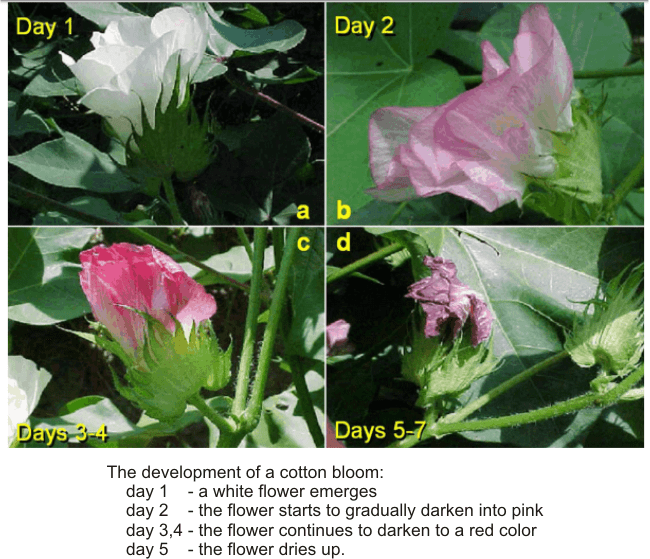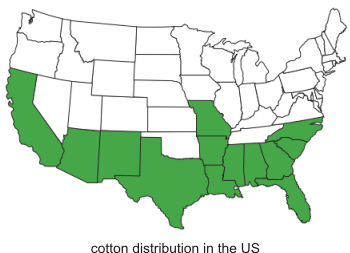Cotton honey first sounded like a joke to me. I mean, cotton is for clothes, for good quality clothes, breathable and soft.
The only image I had in mind of the plant named cotton, was from an old movie where black slaves were gathering white balls of fluffy cotton from a huge field. (city girl – what can I say!) I remember the contrast between their black ebony hands and the white balls.
I never imagined honey can be produced from those plants, because in my mind there were no flowers attached. But then, I thought the same when I first heard of pine honey. Pines don’t have flowers and yet honey can be produced from them. (see honeydew honey)
Somehow cotton honey is a mixture of floral honey and honeydew honey. You’ll see why.
Scientific name: Gossypium hirsutum L.
Other names: cotton, baumwolle (German), cotonnier (French), algodonero (Spanish), cotone (Italian)
There are lots of species of cotton and honey can be produced from all of them. But the most common is Gossypium hirsutum L. (>90% of world production), followed by G. barbadense (3-4%), G. arboreum and G. herbaceum (together, 2%).
Cotton is a member of the mallow family which includes cultivated hibiscus plants, hollyhock, and okra. Swamp mallow, particularly attractive to bumble bees, is found along the banks of irrigation ditches and bodies of water.
The cotton balls don’t appear from nowhere. First there are flowers and then the balls appear. This is something omitted by the laid persons, because the flowers only last for 5, maximum 7 days – like they’ve never been there!
When they first bloom, cotton flowers are pure white or creamy. Over the next few days, the blossom turns pink and then red before drying up and dropping off within a week. The whole flower lasts for only 5 days. A cotton boll takes the place of the flower, eventually cracking open to reveal the tufts of white cotton on the inside.

I found the picture above in a 2004 study, Cotton Growth and Development, by Glen L. Ritchie et al. from the The University of Georgia College of Agricultural and Environmental Sciences. If you are interested in growing cotton, or simply curious about it, I highly recommend it.
As short as these flowers’ lives are, the flowering is very important to cotton production because only pollinated flowers form cotton bolls. The cotton flower contains both male and female parts and the pollination usually occurs within a few hours after the white flower opens.
Cotton is one of the leading honey plants in the southern U.S. and this helps beekeepers a lot because there are times in the year, like in July and August, when there is absolutely nothing else blooming in South Alabama – for example. 
If you cannot easily find monofloral cotton honey, though there is so much cotton in the US, it is because this type of honey is mixed with other varietals and sold
Cotton is something we cannot live without. The white fluff is woven into fabric and this makes cotton more valuable than gold. And besides cotton honey there is also another cotton byproducts: cottonseed oil. Some say that if you’re not frying your turkey in cottonseed oil and drizzling cotton honey on your biscuit, it’s high time you started. 🙂
How is cotton honey?
It’s a combined honey. Made from the nectar of the flower and also from the honeydew the honey bees find on the plant. Or, as a beekeeper puts it: “Honey bees forage cotton on both its internal and external nectaries.”
The flower of the cotton is attractive to bees and offer some nectar only in its first day of blooming, when it is white or creamish (pale yellow). When the flower changes color the bees move to collect another type of nectar they find from the green-colored bracts, leaf-like flower parts on the base of the flower. They also find nectar secreted from the under-side of the leaves.
Honeydew is usually found on trees, but also on cotton and some other plants like lucerne (alfalfa) and sunflower. The honeydew is a sweet liquid secreted by aphids after feeding on the plant’s sap. Honey bees like it too. In Texas for example, there are three species of aphids (aka plant lice), which commonly feed on cotton plants: the cotton aphid, the cowpea aphid and the green peach aphid. (What is honeydew honey?)
The flavor of honey collected from the leaf (extra-floral) nectaries of the cotton-plant in no way differs from honey collected from flowers.
A hectare of cotton plants in bloom yields from 100 to 300 kilograms of honey. Cross-pollination by bees increases the cotton crop by 40 to 56 per cent.
Characteristics of cotton honey:
Color: light amber
Taste and flavor: pleasant, buttery, yet with a definite tang. Some people say the flavor makes you think more of a hard lemonade than a fluffy cloud!
The taste changes depending on the soil type and cotton variety, which influenced a lot the nectar yield.
Sweetness: strong
Aftertaste: faintly spicy. After eating it one should notice a slight tingle at the back of the throat – like a very mild chili.
Crystallization: fairly rapidly into fine grains, in about 4 weeks. Some people appreciate this, saying that crystallization process mellows the honey making it much better. Because of this fast crystallization rate, it is often sold to consumers as a thicker, spreadable product.

Tough in the US cotton covers large areas, the composition of honey has similar values. According to “Composition of American honeys”, By Jonathan W. White, United States. Dept. of Agriculture, published in 1962, the differences in cotton honey harvested in Texas, Arizona and California are not significant. Only the Californian cotton honey is slightly higher in sucrose and lower in pH and ash. Their mean values are as follows:
Water content: 16%
Levulose: 39.42%
Glucose: 36.19%
Sucrose: 1.16%
Maltose: 4.80%
Diastase content: 17.6 DU (low diastase activity)
pH: 4.31 (3.9 in cotton honey from Greece)
Free acidity: 24.86 meq./kg
Amino-acids present in cotton pollen: aspartic acid, serine, glutamic acid and threonine – these are predominant amino acids in floral nectar of three cultivars from two locations.
Only glutamic acid + glutamine was a major amino acid in extrafloral nectar (HANNY and ELMORE, 1974). The content and quantities are influenced by environmental conditions, time, cultivars and water content and less by pesticides. (source)
Antibacterial properties:
Cotton honey has a high antibacterial potency, like buckwheat, blueberry, heather or manuka honey. Remember that whenever we talk about the composition and health properties of honey we are referring to raw fresh honey only.
Cotton honey in cooking:
Cotton honey is an excellent table honey, and its mild taste makes it a good choice for use in cooking and baking where a subtler sweetness is desired. It pairs well with hard cheeses such as Parmesan, but also makes a perfect complement to a citrus sauce, or for a lemonade or tea.
It also makes a good mead.
Cotton honey is not organic
There is no cotton crop today that is free of pesticides. In fact, cotton is one of the world’s most chemical-intensive crops. Growing cotton today requires many applications of insect-killers, weed-killers, plant growth regulators and other types of pesticides. All chemicals are present here: herbicides, insecticides and miticides, fungicides and harvest aids. Nothing is missing.
And while these chemicals are toxic to honey bees and nectar, the genetically modified varieties of cotton affect nectar yields, with some varieties producing next to zero nectar.
A person is exposed to all these chemical only by living next to a cotton crop.
I know that there still is organic cotton in this world. Somewhere. Wikipedia says “Organic cotton is generally understood as cotton and is grown in subtropical countries such as Turkey, China, USA from non genetically modified plants, that is believed to be grown without the use of any synthetic agricultural chemicals such as fertilizers or pesticides.”
♣ Organic honey vs regular honey
In the USA, it is required by the law that any producer wanting to label and sell a product as “organic” must meet the standards established by the Organic Food Production Act of 1990, enforced by The State organic program (SOP).
Personally I do not believe the producers telling they sell organic cotton honey, like it is the case with this jar sold on Amazon: Honey Land 100% Pure Cotton Honey, Kosher, Raw, Organic, Unfiltered, with Many Health Benefits! Convenient Family Size 500gr 17.5oz Plastic Jar, Pesticide Free, Tea and Beverage Sweetener
They do not specify the source of the honey, and except they own a personal cotton crop, there is no such thing as a free of pesticides cotton field. And a beekeeper would use his land to grow more valuable and profitable plants to get healthy honey.
Organic cotton honey is possible only on condition that the beekeepers agree with cotton farmers so they are told when sprays are happening so they can move their hives. Beekeepers say this is possible, farmers tell them when they intend to spray the crops, so their bees don’t die. This happens from time to time during the season.
It can also be the case with the honey sold above, but they don’t mention this kind of info anywhere.
Which is why if you want to taste cotton honey I recommend you turn to a sincere producer, like Sheefa, which says its honey is raw and does not say anything about being organic: Raw Cotton Blossom Sheefa Honey.
===========
===========
References:
https://en.wikipedia.org/wiki/Gossypium
http://www.beefolks.com/shopdisplayproducts.asp?id=83&cat=Cotton+Honey
https://www.bjcp.org/mead/varietalguide.pdf
http://lubbockonline.com/local-news/2012-09-11/cotton-yields-honey-blossom-and-cooking-oil-seeds
http://peacebeefarm.blogspot.ro/2010/07/cotton-in-bloom_26.html
Stefan Bogdanov, Bee Product Science, February 2014, www.bee-hexagon.net
